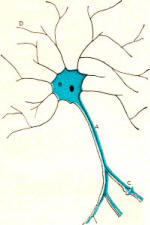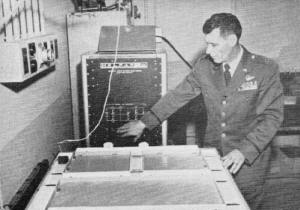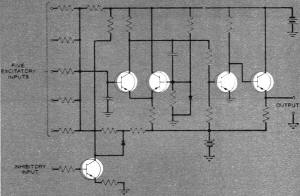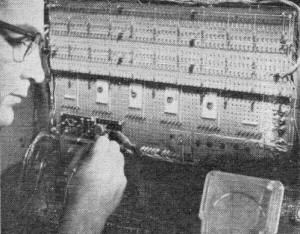Bionics... a Weird World
|
|
Here is an interesting article that appeared in a 1962 issue of Popular Electronics magazine discussing some of the early electronic system developments that were based on sensory elements found in nature. I'm a bit surprised and disappointed that the author made the mistake of equating a bat's sound-based detection and navigation system to radar rather than sonar. Yes, the principles of operation are the same regarding transmitting a signal and then computing the distance based on the round-trip time of the reflected signal, but there is a fundamental difference between radar which uses radio (the 'ra' part of radar) signals and sonar which uses the sound (the 'so' part of sonar) signals. I would bet that if I had the following December or January edition of the magazine, I would find a letter to the editor pointing out the error. radar = radio detection and ranging | sonar = sound navigation and ranging Frog's Eye Points the Way Toward New "Selective-See" Radar Nature is the teacher, man the student, electronics the gainer in this strange new scientific venture
Bats, they discovered, had been using their own personal radar systems to steer in the dark before man was even "out of the trees." Had we known as much about bats as we do now, radar and sonar might have been developed decades earlier. Are there other areas in which we can learn from nature? Researchers in the exciting new field of bionics - the science of building electronic circuits that copy living creatures - say there are hundreds, maybe thousands of such areas. Bionics scientists are taking advantage of the fact that through millions of years of trial and error, nature has developed creatures that can perform tasks of unbelievable precision and complexity. One example: a tiny hummingbird navigates 4000 miles so accurately that he ends up in the same nest he left the season before. A second example: a mosquito can detect the faint buzzing of another a hundred yards away, in spite of howling winds, thunder, screaming sirens, and other ear-splitting noises loud enough to drown out a brass band or a fire brigade! Fly was source of "new" gyroscope developed by Sperry Rand, yet insect's "flight instrument" is 50 million years old! Incredibly complex but extremely effective, a frog's eye responds only to the two things that interest a frog most: bugs (food) and large objects (danger). Frog's eye center inhibition photocell illuminated. Frog's eye center photocell in shadow. Frog's eye center photocell and excitatory photocell in shadow. Bat has used [son]ar - one of nature's many secrets - for countless centuries, but man stumbled onto the technique only decades ago. From Beetles to Flies. By studying these creatures and finding out how they perform their seemingly impossible jobs so easily and accurately, bionics scientists are getting clues on how to build better electronic gear. Here's what's already happened . Two scientists in Tubingen, Germany, wondered how one kind of beetle, being such a little fellow, could keep such ac-curate track of his position. They put the bug in the center of a revolving cylinder so that a moving pattern of lights played over him. And they found that the way he turned depended on the direction and speed of the moving lights. The beetle's eyes - multi-faceted like a cut diamond - could accurately integrate information to judge speed and direction. American engineers used the same principle to build an artificial two-faceted eye which can also calculate the speed of moving-light patterns. Put it in a plane, aim it toward the ground, and it becomes a highly accurate new kind of ground-speed indicator. Why will frogs try to eat anything roughly bug-sized which moves into their range of vision, yet starve to death when knee-deep in freshly killed insects? Investigators at M.LT. moved objects of all sizes and shapes in front of frogs, then recorded their brain waves. Their findings: a frog's eye doesn't see bugs at all. But it is a cleverly designed sensor that detects two things: moving, bug-sized objects within range of the frog's tongue, and large objects - an approaching bird, for example, which might be an attacker. The first signal makes the frog try to eat whatever comes within range; the second sends him hopping for cover. (One scientist pointed out that the frog must also be able somehow to spot objects his own size, or there wouldn't be any more frogs!)
Using the principles learned from the frog, RCA scientists are building an electronic eye which will be able to spot moving targets and ignore all others. A new kind of radar that will record only important data, and eliminate everything else from the screen, could come out of this work. Using a frog's eye as their model, scientists at Bell Laboratories have devised an experimental electronic "bug detector" which may well form the basis of much more important developments. Since the center photocell is connected to the "inhibitory" input, the neuron will fire only when a small object cuts off the input to this cell alone. Possible outgrowth of the study: a new kind of "selective-see" radar, so discriminatory that it will show only the desired data, eliminate all extraneous material from its screen. Scientists at the Rockefeller Institute in New York found that the horseshoe crab was perfectly adapted to seeing in a murky, underwater world. The reason: his eyes automatically make objects stand out more clearly. General Electric engineers took the basic principle and designed electronic equipment to do the same job. They came up with gear that may help make weak TV pictures from space satellites much sharper and therefore much easier to analyze and interpret. At Sperry Rand, engineers wondered how a fly managed to flit around so erratically, yet maintain perfect balance. The answer: flies have two tiny gyroscopes. Unlike our rotating gyros, though, the flies' stabilizers vibrate like a tuning fork. Sperry has built a model about the size of a flashlight for keeping missiles on course.
It's easy to see how a single bat flies into a cave, sends out his personal radar bleeps, and spots obstructions. But bats seldom fly singly. Hundreds - or even thousands - swarm into caves at once, all with their radars going full blast. With thousands of nearly identical echoes bouncing in every direction, how does a bat spot his own? To find out, Bell Labs scientists anesthetize bats, insert tiny microelectrodes into their ear nerves, play recorded bat squeaks, and see what kind of signal the nerve puts out. If they ever find out how the bat makes himself jam-proof, they may be able to apply the same principle to radar. Insect Guidance Systems. Electronics scientists have done wonders with microminiaturization, but Mother Nature makes their efforts seem clumsy. Take navigational gear, for instance. A reasonably accurate guidance system which takes bearings on the moon or stars can be built to fit into an airplane or missile. With latest miniaturization techniques, it may be only as big as a football and weigh hardly more than five pounds. The common sand flea navigates around the beach by taking bearings on the moon, too. Yet his entire navigation system is smaller and weighs less than the period at the end of this sentence. A gentleman silk moth, looking for his girl friend, spots her a mile away by her aroma. His sensitive smeller detects as little as one or two molecules of scent floating in the air. By comparison, our noses require thousands of molecules before we become aware of even the faintest odor. An electronic nose as sensitive as the moth's would make a dandy gas detector. It could analyze unknown compounds in the laboratory by sniffing them, identify a handkerchief's owner more quickly and accurately than a bloodhound, and detect the first hint of food spoilage long before noticeable or harmful decay could set in.
Neuron Nets. All the projects mentioned so far have to do with receptors: the devices living creatures use to see, hear and feel. But what really gets bionicists excited is the more far-reaching problem: how do they think, reason and learn? With answers to questions such as these, we'll be able to build computers that are not simply souped-up adding machines, but which can reason and learn like living things . Key "switch" in living creatures is neuron cell. When impulses come in on dendrites (D), body of cell (B) "fires." Output pulse leaves on axion (A), passes along to the next cell via synapse (C). The secrets are locked in the basic nerve cell, the neuron. These tiny building blocks of all living brain and nerve systems, scientists now know, are basically switches. A neuron has many inputs (perhaps several thousand) and one output. Some of the inputs tend to turn it on - make it "fire" or generate an output pulse. Others tend to keep it from firing. Whether it fires or not depends on the balance of "ons" and "offs" at the inputs at any given moment. Some two to three billion neuron pulses are shooting through your nerve/ brain system every second. Your eyes alone may generate as many as two billion and send them streaming along the incredibly complex interconnected nerve pathways to your brain. Still only dimly understood is what the brain does with all these pulses - how it tells from a lot of little spikes of electricity what your eyes are seeing. Big hurdle for electronics scientists "copying" nature is in perfecting devices which can "think," just as nature's can. Progress in this area is far from scanty: bionic "mouse" pictured here can learn to run maze just like real mouse. Apparatus in background is bionic mouse's "brain." Electronic neuron in schematic above was developed by Bell Laboratories, works much like natural neuron. When enough signals appear at its five inputs, circuit generates a single output pulse; device requires bigger signal at excitatory inputs if signal appears at inhibitory input. Mounted on printed-circuit board (left), electronic neurons are assembled into experimental networks (one appears in background). Bionic machine built by Ford Motor's Aeroneutronic Division, uses artificial neurons, can learn to recognize letters of the alphabet. But with an increasing understanding of the operation of neuron nets, scientists are beginning to be able to duplicate some nerve cell functions in an elementary way. An artificial neuron designed by L. D. Harmon of Bell Labs has five inputs which can be stimulated to fire the neurons, and one which inhibits firing. Bell scientists used this artificial neuron to build a simple "bug detector" similar to the frog's. Bionic "Mouse." As mentioned earlier, RCA is working on a far more complicated moving-target indicator containing hundreds of neurons which operates on the same principle. But perhaps the most important piece of neural-bionic hardware to come out of the laboratories so far is a "bionic mouse" built by the Mel-par Corporation. The "mouse" is housed in a small red plastic case about the size of a matchbox, mounted on wheels. A thin umbilical cord of control wires, suspended from a freely moving arm above, allows complete freedom of movement and connects the mouse with its "brain" mounted in a relay rack. Although the mouse looks like a toy, U. S. Air Force scientists working with it aren't playing. They are convinced that the mouse is the first step toward a completely new kind of thinking machine, as different from today's conventional computers as a superhettfrom a crystal set.from a crystal set. Not long ago, in a laboratory at the Wright Air Development Center in Dayton, Ohio, the author saw this "mouse" put through its paces. A technician placed it in a maze and flipped a switch. The mouse ran down alleys, turned corners, came to dead ends and backtracked, and tried other routes. Forty-five minutes later, after exploring scores of wrong turns and dead ends, it reached the end of the maze. The operator picked it up, and set it back at the beginning. The second time round the mouse made fewer mistakes, and covered the course in about half the time. On the third attempt it ran through in eight minutes. Six tries later, it whizzed through the course in 45 seconds flat without a single error. The mouse had learned the maze, just as a live mouse would! Bionic devices display true - though limited-intelligence in the animal sense. The bionic mouse has only 10 neurons in contrast to our 10 billion, but like an animal it can adapt to changing conditions and learn from experience. Change the maze, and it's confused - at first. But then it settles down and learns the new pattern. A bionic "brain," in other words, can operate from generalized instructions. In the case of the "mouse," the only command was "learn to run the maze." Scientists call the mouse a self-organizing system which, on the basis of generalized instructions, figures out how to do the job. Human beings are self-organizing, too. A computer, on the other hand, has to be "programmed"-instructed in detail on every step. It must be told when to turn, when to store correct steps in its memory, and so on. Pattern Recognizers. Bionic brains will eventually take over hundreds of jobs which are now too complex for computers. They will, for example, work perfectly as pattern recognizers. Airborne Instruments Laboratory already has a bionic pattern recognizer which peeks through a microscope and tells cancerous cells from healthy ones by their size, shape, and general appearance. A Lincoln Lab version looks over electroencephalograms and spots abnormal brain waves. Bionic pattern recognizers may someday approach the capabilities of the best pattern recognizers to date: human beings. Even a baby not yet able to coordinate well enough to put one block on top of another can instantly differentiate between his mother and any other human being. Yet the most advanced computer can't approach this kind of precision. Future bionic pattern recognizers, though, will distinguish faces or objects of any kind. Such a device could be put in a missile, shown a map with an "X" at one point and told to fly over enemy territory until the ground pattern matched the map, and then zero in. Handwriting is a pattern, too. An "a" made by one person is very different from an "a" made by another, yet human beings recognize "a's" easily and read handwriting. A computer can't do it nearly as accurately as a person can, but there's no reason a bionic brain won't be able to - and do it much faster than people. Speech is little more than a pattern of sound waves - also recognizable by a bionic brain. Dr. Frank Putzrath of RCA is building an electronic ear which will use a network of artificial neurons to tell one word from another in much the same way human beings do. With a bionic listener, a business man could dictate letters to his typewriter. Similarly, a battle commander could direct automatic tanks, missiles, and guns - just by talking to them. Educating Bionic Brains. Such brains would share many characteristics with human brains, among them, the necessity to learn. Today's computers are ready for operation as soon as the last soldered joint cools. A bionic brain, though, said Captain Leslie Knapp, one of the Air Force's top bionic scientists, might have to sit on the shelf for a year or more to become educated. During that time, 24 hours a day, and at electronic speed, it would soak up libraries of information about scores of different subjects. Then, when given instructions to translate a paper from one language to another, for example, it would know how. The usefulness of such bionic machines can hardly be overestimated. A bionic robot, for instance, could be sent to explore the moon. No computer small enough to fly in a space ship could possibly be programmed to know how to deal with every possible condition it might encounter. A relatively small bionic brain, though, able to adapt to conditions as it found them, would be a perfect agent for the job of taking man's place on the moon. Bionic machines may help keep man from being overwhelmed by the fantastic amount of information he has to receive, analyze, and digest in this age of science. TIROS weather satellites, for example, have helped weathermen sharpen their weather eyes, but they've brought problems, too. The flying weather station spews forth thousands of pictures every day - so many that it becomes almost impossible just to look at and interpret each one. As more weather stations go into operation, the situation could become unmanageable. With a bionic brain aboard, a TIROS satellite could look over each picture to see if it contained important information. Then only pictures with special patterns - those showing incipient hurricanes, for example - would be transmitted to the ground. Similarly, a Midas "spy-in-the-sky" satellite could be directed to be on the lookout for troop movements and ICBM launchings. We can expect bionic brains to run factories and offices, control traffic, keep track of national production, forecast weather, and do thousands of other jobs in our society. As the industrial revolution produced machines to relieve men of physical drudgery, the coming bionics revolution should bring forth devices to relieve him of mental drudgery.
Posted May 3, 2021 |
|

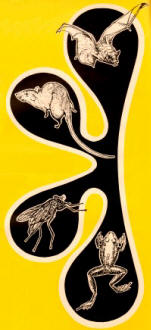
 Scientists who "invented" radar just before World
War II found themselves in for a surprise. Shortly after the first successful units
went into operation, they realized that their invention wasn't new at all. In fact,
it was millions of years old.
Scientists who "invented" radar just before World
War II found themselves in for a surprise. Shortly after the first successful units
went into operation, they realized that their invention wasn't new at all. In fact,
it was millions of years old. 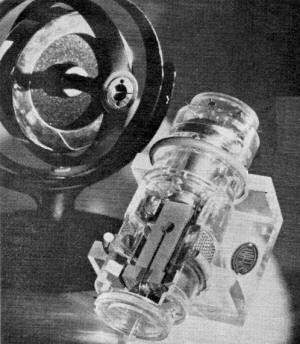
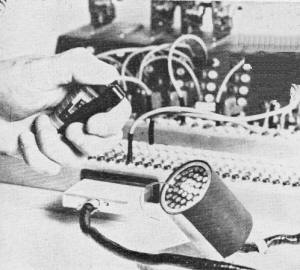
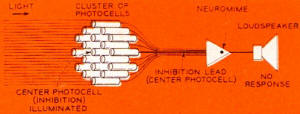

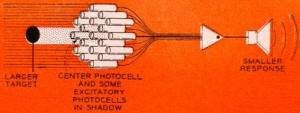

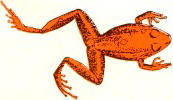
 Jam-Proof Bats. Other scientists are
working overtime to uncover scores of natural "secrets" that may give clues toward
building more useful equipment. At Bell Labs, workers are trying to find out exactly
how a bat's super-sensitive hearing works. We already know about his radar, but
they think we may still be able to learn a trick or two from the furry flying mammals.
Jam-Proof Bats. Other scientists are
working overtime to uncover scores of natural "secrets" that may give clues toward
building more useful equipment. At Bell Labs, workers are trying to find out exactly
how a bat's super-sensitive hearing works. We already know about his radar, but
they think we may still be able to learn a trick or two from the furry flying mammals.
 The praying mantis houses a computer of unbelievable
speed and accuracy in his match-head sized cranium. The insect's eyes see a bug,
and transmit data on the size, speed and trajectory of the flying snack to his brain.
Instantly, the brain goes into action, processes the information like a gun-aiming
computer, and tells him where the bug will be a fraction of a second later. His
head shoots out, and the flying bug becomes lunch. The whole operation takes one-twentieth
of a second. Our tracking systems, weighing tons, aren't that good.
The praying mantis houses a computer of unbelievable
speed and accuracy in his match-head sized cranium. The insect's eyes see a bug,
and transmit data on the size, speed and trajectory of the flying snack to his brain.
Instantly, the brain goes into action, processes the information like a gun-aiming
computer, and tells him where the bug will be a fraction of a second later. His
head shoots out, and the flying bug becomes lunch. The whole operation takes one-twentieth
of a second. Our tracking systems, weighing tons, aren't that good. 